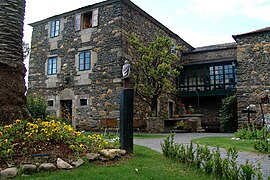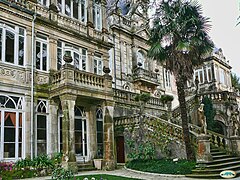Pazo

A Pazo is a type of
The pazo, as a traditional civil architectural structure, had associated a social network: the servants of the nobleman and the tributaries of the domain, who themselves came to live on the grounds of the pazo (mostly the former). A pazo usually consists of a main building surrounded by gardens, a dovecote and often include outbuildings such as small chapels for religious celebrations. An example being the pazo de Cadro in Marin, the seat of the House of Romay, which had a chapel dedicated to Santa Barbara.
The word pazo is a cognate of stately palace, and comes from the Latin palatiu(m). As a curiosity, the Portuguese word, close to the Galician language, to say palace is paço (instead of palácio). In this regard, the Paço Imperial in Rio de Janeiro, built in the 18th century, is an example of the Portuguese counterpart of this type of building.
Gallery
-
Pazo Pondal, Ponteceso
-
Pazo de Mos,Mos
-
Tower and pazo de San Miguel das Penas, Monterroso
See also














